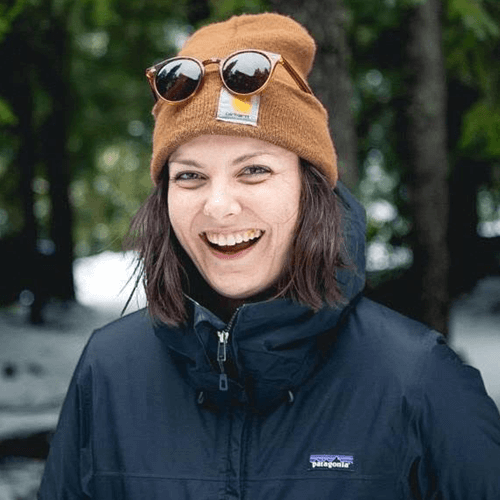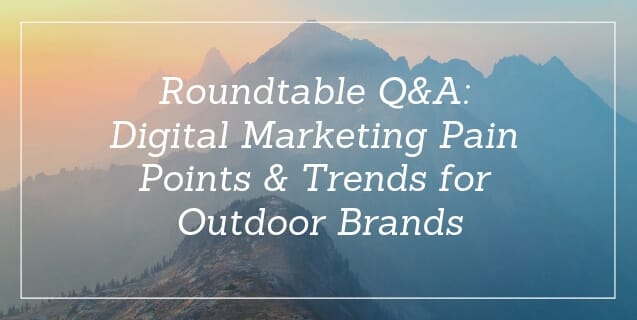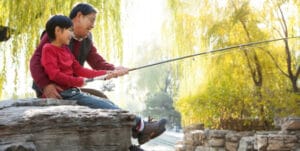Filling your lungs with fresh air as you gaze at Mother Nature’s handiwork is exhilarating. We love feeling the Earth beneath our feet and sharing how to enhance those experiences.
Today we’re reflecting on what’s coming up in the year ahead for digital marketers who represent the outdoor brands that take our adventures to the next level. We’re discussing pain points and how to revolve them; digital content trends and staying relevant to our audiences and are opening up about who we should target in our upcoming campaigns to be effective.
It’s an eye-opening, validating conversation with many actionable takeaways that we hope will inspire your approach to outdoor marketing in the year ahead too.
Meet Our the Roundtable Guests
We gathered insight from a handful of marketing professionals who spend their days thinking about the outdoors — absorbing it, preserving it and sharing it with others.

Danielle has worked with some of the biggest players in the mountain sport and tourism industries. With strong insights into brand and consumer engagement, Origin’s creative leader oversees the brand development and creative by-products of multi-channel campaigns and strategies for all of Origin’s clients. A sought-after speaker, an avid snowboarder and mountain biker, and with a client list that reads like the who’s who of outdoor sports means Danielle’s “downtime” is spent traveling to some of the best mountain destinations around.

A creative, strategic thinker with an instinct for the next, Harriet Riley crafts savvy plans to bring ideas to life in the digital realm. As Lead Digital Content Strategist at Nemo Design, her approach isn’t just throwing another ad in people’s feed. She seeks to add value to the platforms, ignite conversations, and create more possibilities for people to engage. If you give consumers a path and reason, they’ll come to brands on their own term for the long term.

When he’s not climbing peaks or fly casting to trout, Brian Lich is a Senior SEO Specialist at Volume Nine. At V9, he works specifically to help companies ‘Turn Up Their Brand’, so to speak. Essentially, it’s the V9 way of helping outdoor brands play above the online noise, by aligning all channels toward a singular goal and cutting through the clutter.

Crystal Stewart launched her career in travel and outdoors 14 years ago at a Destination Marketing Organization. She has since expanded her marketing and media prowess across all aspects of outdoors over the past 11 years at Booyah. Her experience spans outdoor gear brands, outfitters, National Parks, ski resorts, and more. Her passion for the outdoors and love for travel keep her loyal to this industry for life.
And now, on to our three-part discussion!
Brands Have Pain Points
Q1: As the outdoor industry evolves, there should be some common recurring issues that emerge. Can you share a handful of the most common concerns outdoor brands face within this competitive market?
Crystal, Q1: Understanding goals and where marketing focus should weigh most heavily. Most commonly, brand marketers do not have knowledge of their customer retention rate, ways to re-engage their customers and ultimately drive higher loyalty and customer lifetime value.
Harriet, Q1: From a marketing and advertising perspective, the key recurring issue is having to make quick, game-time decisions with an outdated understanding of the market. We have the data that proves there’s an influx of new outdoor participants and the corresponding demographics. Yet, we lack compassion and storytelling around these new individuals. We don’t have a clear picture of why they are coming into the space, what they are seeking from outdoor brand and how they find them. Every brand is left to understand and fend for themselves.
Here are three main concerns I often tackle with clients:
Representation: Brands have to choose who to represent in the marketing material. Until recently, this choice has been relatively simple, as it’s often mirroring the brands strategic target. If you’re selling skis, show a skier using them. Better yet, show a competitive athlete using them. These days, it’s a bit more difficult because brands have been pushed to the front line of culture. Here, they’re being pressured to use their voice and market presence to get up and outside of themselves – by galvanizing a bigger cultural issues that surround their brand/product/business. We’ve seen many brands edge into women’s and minority marketing, which has been awesome to see but it does beg the question: is it a true stance, or just marketing for marketing sake? It’s clear that getting outside of the high earning, single income, Caucasian household narrative is enough to be differentiated, but where does it go from there? These are the kind of questions that are a concern to the Outdoor industry, for one misstep can lead to a proper thumble in the marketplace. Diversity and inclusion are too big of marketing issues today for the Outdoor industry to ignore.
Copy: A second concern for outdoor brands is copy. From headlines to CTA’s, almost all brands sound the same. I believe this is because all copy is still written for that long-standing strategic target. If we can evolve who we represent in the marketing material, then perhaps we’ll also evolve the way we speak to them. I am not simply pointing to a language translation or a change of tone. I mean, everything that copy is responsible for – attracting us, helping us, indulging us… it’s just as important to speak someone’s language as it is to show them.
Ecosystem: A third concern is the ecosystem a brand creates for its community. Right now, almost all brands have look-a-like ecosystems that tend to be very clunky. Newcomer brands are bringing with them exceptional UX/UI, SEM, CRM, etc that make the older brands feel really…old. Just as much as Outdoor brands need to heavily consider who they represent and how they talk to them, they also need to be thinking about providing a frictionless experience.
Brian, Q1: Developing a successful approach for Amazon is an immediate pain point which comes to mind. For some brands, this may seem like a no-brainer, but Amazon Marketplace is not always a good fit. We find ourselves approaching this issue often and we’re confident it’s felt by many brands within the Outdoor Industry.
Danielle, Q1: The biggest issues—and frankly they are ones that the industry has been giving lip service to for many years—are accessibility and inclusivity. Presenting the outdoors as a challenge or threat to be conquered was a mechanism for performance brands to showcase their technical product. Their successes resulted in most outdoor brands adopting that same technique, and as a result the outdoors is generally presented as in inaccessible place that requires special skills, knowledge, guidance and gear. This has begun to change in recent years with challenger brands adopting different approaches. On the inclusivity front, the “whiteness” of outdoor participants was identified over a decade ago as a barrier to growth. Representing ethnic and gender diversity has become a priority in outdoor sport marketing, but so often it feels forced.
Q2: What solutions or strategies have you found to be successful in alleviating these problems?
Crystal, Q2: Building a cohesive omnichannel strategy that focuses on the entire customer journey and loyalty loop. Benchmarking new versus repeat customers and applying ad strategic targeting approach for driving repeat purchases and booting average order value of repeat purchasers. Likewise,having unique goals associated to each channel and where consumers are with their loyalty level. For example, understanding the potential higher ROI of marketplaces such as Amazon or retail sales velocity of 3rd party retailers and weighing against the cons of missing personal customer data. A smart marketing approach have a balance of all of these platforms and incorporate strategies for building a brands direct to consumer relationship and loyalty through direct site buys and email sign-up.
Harriet, Q2: Data-driven insights: Getting in front of real people is often time-consuming, difficult and expensive. This is why I think many brands start to revert to their own experience and intuition. I strongly believe that we should be paying attention to the online conversation to uplevel key insights… it’s a great way to peg away at producing original content.
Targeted Creative: Focus on one big content shoot with a variety of talent. Take the time in post-production to break up the content pieces, pair it with tailored messaging and put it on the right platform. Just because there’s diversity in the market, doesn’t mean that each segment needs its own shoot.
Redesigning the online experience: Optimize all web experience to be a 1-3 click process that is super easy and simple to navigate. Capture sales by making it easier to make the purchase.
Brian, Q2: Being methodical and diligent, while ignoring a one-size-fits-all approach to Amazon.
Danielle, Q2: This year Origin produced a short film for Canadian outdoor retailer Mountain Equipment Co-op (Canada’s version of REI), called Facing Sunrise. The film featured the story of a 40-year-old Muslim woman’s introduction to hiking and camping. During production, skeptics suggested that it “wasn’t mountain enough” to attract the audiences we were looking for. The project was vindicated when it won “Best Short Film” at this year’s Banff Film Festival. I think that win speaks to the type of stories that outdoor sport audiences are now looking for.
Digital Content Trends
Q1: Where do you see marketing for the outdoor brands industry trending in 2019 in terms of messaging context and publishing formats for digital content?
Crystal, Q1: Maintaining brand and price consistency across all platforms and distribution points is important to consumers and partner retailers. For example, we recently took over a winter outdoor gear brands Amazon presence and paid digital marketing programs. Our first work of order was to get Amazon listings optimized and pricing in-line with their website to get a true gauge of performance, unbiased by price. The result of having price control alone led to them selling out of product on Amazon and their website. What happened following was a pleasant surprise to all of us – the brick and mortar stores that historically denied their product because of price concerns started surfacing and ordering their product. The echo effect of sales across Amazon, their site and brick and mortar led to two complete restocks from their production facility and with still 2 months left of the season, we’re almost out of product again.
Harriet, Q1: Individualism: Stop speaking to everyone the same way. We don’t all want to get to the same mountain top or bomb the backcountry. Some of us just want real premium gear for the adventure ahead, because none of us now where we’re going, who we’ll meet or where it’ll all take us.
Creative techniques: The outdoor industry is plagued with Kodak moments. Look at how the fashion and music industry have evolved to using creative techniques like glitch, vaporwave, etc to break through. We should be exploring these kind of creative solutions.
Color: We love black and white in the Outdoors. It shows how powerful and timeliness the industry really is, But then brands like Fjallraven and Topo designs, Hydro Flask show up and really stand out with their use of bright color pops. We should all be exploring these different areas.
Brian, Q1: It’s seemingly been a trend for the past few years, but video marketing is here to stay. Making this approach cost-efficient is a challenge and we’re working to improve. Additionally, we’ve seen the industry embrace change, welcome diversity and encourage advocacy amongst customers. Channeling this into a digital marketing approach, we’ve stayed conscious that not all outdoor consumers want to climb Everest, but rather, many simply want functioning equipment that performs well in a variety of conditions.
Danielle, Q1: As marketers we intuitively understand that context matters when we’re looking at media. Beer ads work during a Super Bowl broadcast, designer clothing ads work in fashion magazines, ski gear ads work on outdoor sport websites. What’s driving me crazy right now with marketers buying programmatic digital media placements, is that so many of them appear to be forgetting the importance of their message being in front of the right person at in the right place, at the right time (context). It is so basic, but the almost cult-like adherence to audience-centric buying, is leaving context out of the equation. What’s even more maddening, is that the digital world allows the ad, the message, the context and the audience to be programmed so specifically in ways that could get the perfect alignment, but hardly anyone is doing it. Placements in mass pubs to broad audiences through ad networks is the de facto approach and I don’t understand it.
Q2: How are you adapting your services to stay current and relevant to your audiences in the year ahead?
Crystal, Q2: Amazon is the biggest player in the retail space now and stats show as high as 90% of consumers will leave a retailers site or store to buy the product on Amazon — for convenience over price. Amazon is a consumer-focused platform and severely understaffed for brand support. Having highly focused expertise specific to Amazon on both the operational and advertising side are helping our clients stay ahead of the curve and increase their market share. Despite Amazon lacks the crucial direct to consumer relationship & customer data sharing, it will only continue to grow and is an absolute must for outdoor brands to lean heavily on.
Harriet, Q2: Consumer Insights: Unique research approached, phased plans and workshops to help set up client teams for success.
Digital Partnerships: Looking outside the outdoor space to bring something new and emerging to the table.
Hiring Digital Natives: Young people simply rule. I love hiring interns and doing workshops with them to find out what brings them joy and confidence to go forth.
Brian, Q2: Because of this, we’re working hard to develop long-form storytelling and brand-building techniques across digital channels, while also recognizing the necessity to address traditional and old-school foundations (i.e. technical health, product page optimizations, CRO, etc.)
Danielle, Q2: We’ve hired content strategists and specialists in the areas of social, digital media and distribution, not because we plan on offering that service, but because understanding the publishing suppliers, formats and trends is key to our creative being effective. Gone are the days where media agencies define the buy and creative agencies just produce ads. It is a collaborative process and creative agencies need to understand how to work with their media/distribution counterparts.
Learning About Audience
Q1: Understanding our audiences from both demographic and psychographic perspectives is the key to effective targeting. What population(s) do you see emerging as potential consumers of outdoor products that brands should include in upcoming campaigns?
Crystal, Q1: This is a great question and I suspect it varies widely by category within the outdoor space. For ski, we’re watching the most loyal skiers age and the loyalty among a younger generation fade away – particularly as big season pass conglomerates like IKON & EPIC form. For outdoor gear and outfitters, all ages apply and I have to imagine the longevity created by a healthy lifestyle and life frequently in nature will give these brands a longer customer lifecycle.
Harriet, Q1: Mixed background, leaning Hispanic & Asian: It’s in the data. Both are growing in participation rates, yet we rarely see any of them, or a mix represented.
Non-Outdoorsy, Outdoor Person: Poler Stuff really was onto something. We see Coleman killing it. There’s room to grow!
Brian, Q1: As mentioned earlier, we’re seeing the industry trend toward inclusivity and diversity. For example, during January of 2019, Sisu magazine was launched. This magazine focuses specifically on “women, people of color, trans/femme/binary/genderqueer, and men who have been charging through life, challenging the status quo, and passionately spreading their love of adventure and the outdoors to others.”
Danielle, Q1: The outdoors is hot right now, so we’re seeing new audience segments emerging from within every market—urban, suburban, ethnic, gender, age (young and old), high performance, adaptive, recreational…you name it, there’s a niche audience who are interested in a unique point of view from within it. I think this represents a huge opportunity for brands to double down on specific targets. Our ability today to target through media, makes the opportunity for niche and rich stories.
Q2: How can we capture the attention specifically of these population(s) with all the online noise being caused with so many brands producing content?
Crystal, Q2: The more ad formats, social platforms and web content pages develop, the more cluttered the marketing space will get. Brands do need to find a way to be disruptive with their messaging – be unique in how you target your audience, give a message that resonates with them and deliver it across a combination of ad formats (both rich and direct response) to stand apart. It’s funny, we used to focus so heavily on optimizing to reduced frequency and higher reach when I first started my career in digital marketing. Now, frequency across multiple channels, devices and ad formats is necessary to stand apart. Media strategy must also be coupled with creative execution as creative drives as much as 70% of your campaign’s performance. We believe to never stop testing and evolving your message is crucial at
Booyah. There’s a free tool called Moat.com that may give brands some guidance on what other brands are doing in the display space, at least, and help to think through a strategic approach to creative testing and audience segmentation.
Harriet, Q2: Real Inspiration: Meet them, talk to them, get outside of the Outdoor conversation to get some true story on who they really are, where they come from and where they want to go.
Anti-story arch: Use a video pulsing technique instead of the traditional story-arch. It works with attention spans and is a good way to avoid generalizing audiences.
Core purpose is to be life-changing, social impact: We need to rethink Maslow Hierarchy of needs and how technology plays a role in getting us outside. Right now, the two are at odds but with the growing trends in wearable and health tracking, shouldn’t we be seeing them together?
Brian, Q2: Smaller, more specific audiences allow us to tell meaningful stories and build personal connections with the customer. Be it through social, blogging, email, etc., we find merit in Seth Godin’s minimum viable audience approach. Whether this be for the seasoned ultra-runner looking for the perfect shoe or the urban outdoor hobbyist in search of new rain gear, we try to find the highly qualified audience and speak to them directly.
Danielle, Q2: As I’ve mentioned above, paying attention to niches and micro-markets will be the answer I believe.
Thank you, Crystal, Harriet, Brian and Danielle for sharing your expert insight on where the 2019 outdoor market is trending. In the year ahead we’ll no doubt see an increased focus on goal setting and agile marketing strategies based on real-time data and insights.
We’ll spend more time discovering our audiences. We’ll focus on how and why consumers are finding our products and move beyond the one-size-fits-all approach to give greater attention to accessibility, gender-focused messaging and inclusivity for anyone interested in exploring the outdoors, from mountaintops to community parks.
We’ll be challenged by the wild pricing inconsistencies across online platforms and brick-and-mortar retailers. We’re all learning how to manage Amazon’s domineering retail landscape and how to create messaging that rises to the top. We think relatable storytelling approaches, insight from content strategists and dissecting trends will lead the way.
Interview questions were created and answers were compiled by Chuck Isaac Aikens.


